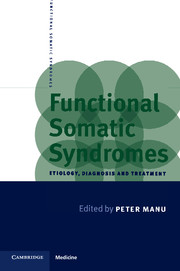Book contents
- Frontmatter
- Contents
- List of contributors
- Preface
- 1 Definition and Etiological Theories
- 2 Chronic Fatigue Syndrome
- 3 Fibromyalgia Syndrome
- 4 Irritable Bowel Syndrome
- 5 Premenstrual Syndrome
- 6 Interstitial Cystitis
- 7 Temporomandibular Disorders
- 8 Chest Pain Syndromes
- 9 Repetitive Strain Injury
- 10 Multiple Chemical Sensitivities
- 11 Psychopharmacology of Functional Somatic Syndromes
- 12 Psychotherapy of Functional Somatic Syndromes
- 13 Determination Of Disability Claimed By Patients With Functional Somatic Syndromes
- 14 Functional Somatic Syndromes: Exploring Common Denominators
- Index
3 - Fibromyalgia Syndrome
Published online by Cambridge University Press: 08 January 2010
- Frontmatter
- Contents
- List of contributors
- Preface
- 1 Definition and Etiological Theories
- 2 Chronic Fatigue Syndrome
- 3 Fibromyalgia Syndrome
- 4 Irritable Bowel Syndrome
- 5 Premenstrual Syndrome
- 6 Interstitial Cystitis
- 7 Temporomandibular Disorders
- 8 Chest Pain Syndromes
- 9 Repetitive Strain Injury
- 10 Multiple Chemical Sensitivities
- 11 Psychopharmacology of Functional Somatic Syndromes
- 12 Psychotherapy of Functional Somatic Syndromes
- 13 Determination Of Disability Claimed By Patients With Functional Somatic Syndromes
- 14 Functional Somatic Syndromes: Exploring Common Denominators
- Index
Summary
Fibromyalgia syndrome (FMS) is characterized by complaints of generalized musculoskeletal pain and the finding on physical examination of tenderness in characteristic regions. Although accepted now as a standard rheumatological entity, the condition still raises basic questions. Do tender points truly define FMS syndrome? Are the number of tender points critical to the diagnosis? Does generalized tenderness indicate a state of increased somatic awareness, hypervigilance or just a lack of discriminatory validity? Do the overlap of FMS symptoms with those of other syndromes indicate a relationship and, if so, what is the relationship? Is the diagnosis of fibromyalgia useful or does it condemn the patient to a sickness? Is FMS the final outcome of one etiological process or of numerous etiological possibilities?
For the most part, the available literature does little justice to the enormity of the questions. Bias is often evidenced by selective reference, inability or refusal to address contradictory findings and the obstinate maintenance of pet theories. Methodological problems leading to questionable results include a small number of patients, lack of appropriate controls and unique, often poorly categorized, patient populations in a tertiary setting. The study of fibromyalgia thus poses a formidable task not only for the investigator but for the physician trying to make sense of the available literature. Nevertheless, the establishment of standard diagnostic criteria has allowed investigations of a defined group of chronic pain patients.
Keywords
- Type
- Chapter
- Information
- Functional Somatic SyndromesEtiology, Diagnosis and Treatment, pp. 32 - 57Publisher: Cambridge University PressPrint publication year: 1998
- 2
- Cited by

